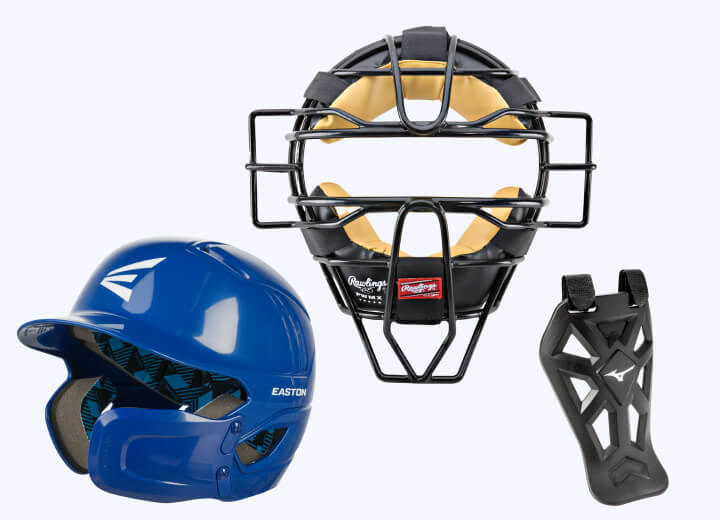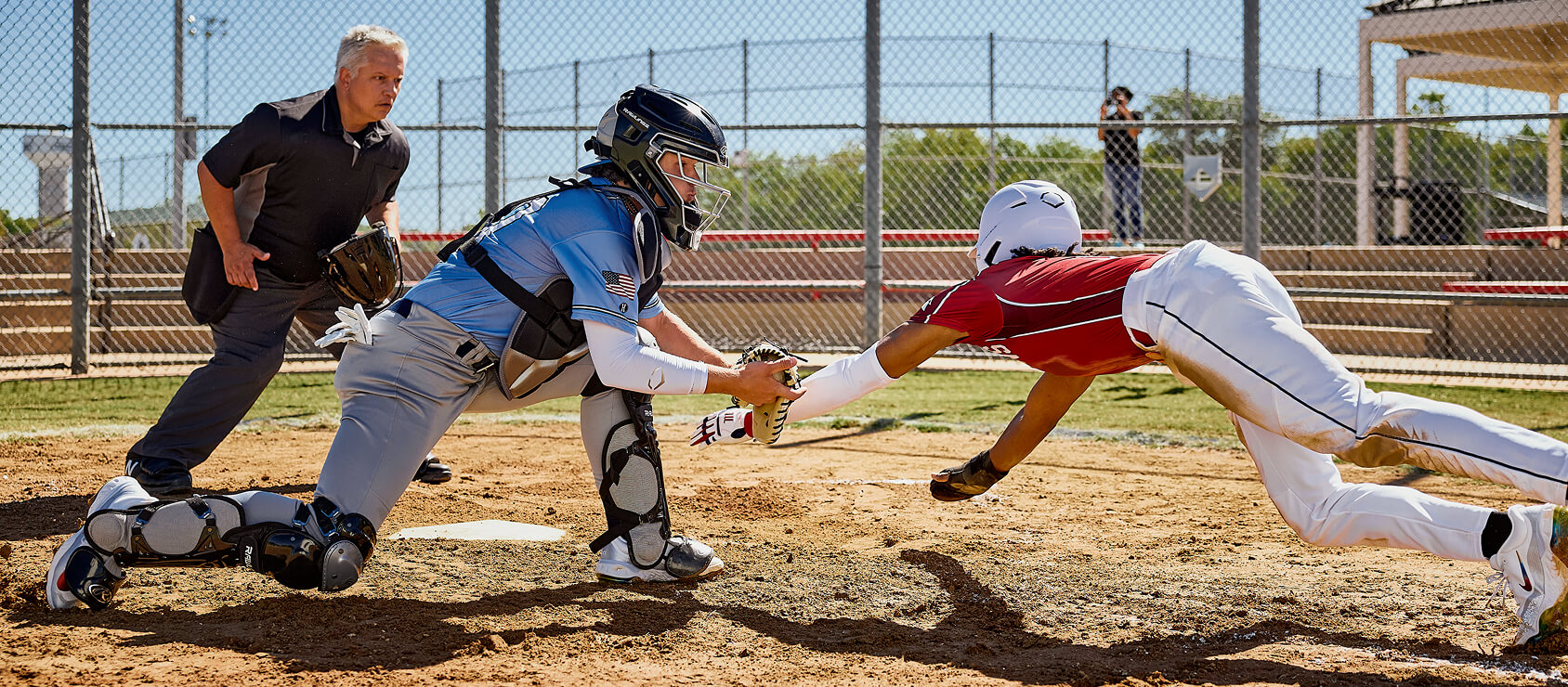Cover Your Bases With Our Baseball Protective Gear List

Stepping onto the baseball field is about confidence, focus, and love for the game. But let’s be honest — staying safe is just as important as swinging for the fences. Whether you’re a catcher bracing for fastballs or an infielder guarding the bases, the right equipment keeps you ready to give it your all. In this guide, our experts break down must-have baseball protective gear so you can focus on enjoying the game.
Key Takeaways
- Do All Players Need to Wear Baseball Protective Gear? — Every player should wear protective baseball gear, but the type and amount of gear they need depends on their position, league, and preferences.
- The Ultimate Baseball Protective Gear List — Discover what gear players need to stay safe and what to look for before purchasing.
- Essential Baseball Protective Equipment for Catchers — Learn what specialized equipment catchers need in addition to the other gear on our list.
- Expert Tips for Finding the Right Baseball Protective Equipment — Get tips from baseball pros on how to find equipment that will last all season long.
Do All Players Need to Wear Baseball Protective Gear?
Not every baseball player needs to wear the same protective gear, but safety is a priority for everyone on the field. The type of gear you need often depends on your position and level of play. Catchers, for example, tend to wear more baseball protective equipment than fielders. While some positions require more equipment than others, the goal is the same — keeping players safe so they can play ball.
Is Youth Baseball Protective Gear the Same as Adult Gear?
Youth players wear the same protective gear as adult players, but it’s designed with younger players in mind. The biggest differences are size, weight, and (sometimes) the level of protection.
Youth gear is typically lighter and smaller to accommodate smaller frames and ensure kids can move comfortably on the field. If you’re buying protective baseball gear for a youth player, make sure the gear you choose is meant for kids, not adults.
The Ultimate Baseball Protective Gear List
From head to toe, this protective baseball gear is designed to shield you from wild pitches, hard hits, and unexpected tumbles. Let’s dive in!
Head Gear: Helmet, Throat Guard, and Faceguard

Baseball helmets, faceguards, and throat guards protect players’ heads, faces, and necks from high-speed pitches, wild throws, and unexpected impacts. While all players can wear them, helmets are typically worn by batters and base runners, and throat guards are worn by catchers. Faceguards can be worn by adult players but are more common in youth leagues.
Here’s what to look for when buying baseball head gear:
- Helmet Fit: Look for a snug fit without being too tight. The helmet should sit level on the head, covering the forehead without obstructing vision.
- Faceguard Compatibility: If you’re adding a faceguard, make sure it’s compatible with the helmet and securely attaches without shifting.
- Proper Ventilation: Helmets with vents help keep players cool during hot games.
- Throat Guard Coverage: Choose a throat guard that’s easy to attach to a catcher’s mask and long enough to cover the entire throat area.
Mouthguard

Whether it’s a foul ball, a wayward pitch, or a collision on the basepaths, a good mouthguard can save players from painful and costly dental injuries. While they’re not required in every league, they’re a smart addition for players of all ages. When buying a mouthguard, here’s what to look for:
- Fit and Comfort: Choose a mouthguard that fits snugly without causing discomfort. Many are boil-and-bite, allowing you to mold them for a custom fit.
- Ease of Cleaning: Opt for a mouthguard that’s easy to clean to keep hygienic between games.
Chest and Rib Protectors

Chest and rib protectors are worn mostly by catchers and youth players to shield their torsos from impacts. They help prevent bruises, broken ribs, and more severe internal injuries. Here’s what to consider when buying a chest or rib protector:
- Proper Fit: The protector should cover the chest and ribs completely without restricting movement. Adjustable straps help ensure a secure fit.
- Impact Absorption: Look for padding made from high-density foam or gel that absorbs and disperses impact effectively.
- Position-Specific Design: Catchers should choose a chest protector designed for crouching and quick movements. Infielders or pitchers might prefer lighter, more flexible options.
Arm and Elbow Guards

Arm and elbow guards help prevent injuries like arm bruises and fractures. Because they’re typically worn by batters, these guards are lightweight and flexible, offering protection without sacrificing mobility. The right arm or elbow guards should have:
- Proper Fit: The guard should fit snugly without pinching or sliding out of place.
- Impact Resistance: Look for hard-shell protection over the elbow and softer padding for surrounding areas to absorb shock effectively.
- Mobility: Choose a guard that allows for a full range of motion so it doesn’t interfere with swinging or running.
- Lightweight Design: Guards should be light enough that players barely notice they’re wearing them.
Leg Guards

Leg guards are typically worn by catchers and batters to protect their knees, shins, and ankles from impacts during the game. Here’s what to consider when looking for the right leg guards:
- Full Coverage: Look for guards that protect the knees, shins, and ankles without leaving gaps.
- Adjustable Fit: Straps and padding should allow for a snug, secure fit that won’t shift during play.
- Flexibility: Make sure the guards allow for easy crouching, running, and lateral movements. Articulated designs are ideal for catchers.
- Lightweight Design: Guards should provide protection without adding unnecessary bulk or weight.
Sliding Pants and Shorts

Sliding pants and shorts are essential for baseball players who want to protect their thighs, hips, and glutes from scrapes and bruises during slides. They have padded areas to absorb impact and reduce friction, making them perfect for aggressive base running or fielding plays. Here’s what sliding pants and shorts should offer:
- Comfortable Fit: They should fit snugly without being too tight or restrictive to allow for a full range of motion.
- Padding Placement: Look for reinforced padding on the thighs and hips where slides and impacts are most common.
- Compression Support: Some sliding pants double as compression gear to offer muscle support and reduce fatigue.
- Seamless Design: Flat seams or seamless construction help prevent chafing during play.
Athletic Cup

Athletic cups are typically paired with jockstraps or compression shorts to keep them securely in place and protect players from groin injuries. While all players can wear them, they are especially important for catchers, infielders, and pitchers, who are more likely to face direct hits. Look for the following when buying an athletic cup:
- Proper Fit: Choose a cup that’s the right size for the player’s age and body type. It should fit snugly without shifting during movement.
- Comfortable Material: Look for cups made of lightweight, impact-resistant plastic with a soft, padded edge for comfort.
- Ventilation: Cups with vents or breathable materials help prevent overheating during play.
- Secure Support: Pair the cup with compression shorts or a jockstrap designed to keep it in place without discomfort.
- Flexibility: Some cups are designed with a contoured shape to allow for natural movement and maximum comfort.
Hand Gear: Mitts, Gloves, and Thumb Guards

While baseball gloves, batting gloves, and sliding mitts may not seem like protective gear, they protect players’ hands and wrists from injuries such as blisters, scrapes, jams, and fractures. For extra protection, pair batter’s gloves with thumb guards to help prevent injuries caused by vibrations and impacts. Protective baseball equipment for hands should feature:
- Proper Fit: Ensure each piece of gear fits snugly without being too tight or restrictive. For help finding the perfect fit, check out our Baseball Glove Size Chart.
- Comfort: Prioritize gear with padding in high-impact areas.
- Position-Specific Design: Baseball gloves should match your position, while sliding mitts and thumb guards should provide the right protection for base running and batting.
- Secure Straps: Adjustable straps on gloves and mitts help keep the gear in place during intense movements.
- Flexibility: Gear should offer enough flexibility for natural motion.
- Impact Protection: For sliding mitts and thumb guards, check for extra padding or reinforced areas to shield fingers and thumbs from injuries.
Essential Baseball Protective Equipment for Catchers
While the above baseball protective gear list applies to catchers, they need some additional, specialized gear to keep them safe during play.
- Catcher’s Helmet and Mask: Shields your head and face from fast pitches, foul tips, and stray bats.
- Catchers Mitt: Features thick padding and a unique shape to handle fast pitches, absorb impact, and protect your hand from stings and bruises.
- Knee Savers: Cushioned pads that attach to leg guards, reducing knee strain and providing extra support during long games.

Expert Tips for Finding the Right Baseball Protective Equipment
- Prioritize Fit: Ill-fitting gear can be just as unsafe as no gear at all. Make sure all equipment fits securely without restricting movement or causing discomfort.
- Check for Breathability: Look for gear made with moisture-wicking fabrics or ventilation features to keep your player cool and comfortable.
- Focus on Durability: Invest in gear made with high-quality materials like durable leather, molded plastic, or reinforced foam to ensure it can withstand repeated impacts.
- Consider Position-Specific Needs: Each position requires different levels of protection, so make sure you’re buying what you need to stay safe.
- Look for Safety Certifications: Ensure all gear meets safety standards set by your league or governing body.
- Test Before You Buy: If possible, try on the gear or have your child do so to ensure it feels comfortable and fits properly. Gear that feels awkward or bulky can distract from performance.
Have Fun Out There!
With protective baseball gear, you can focus on the game without worrying about unexpected injuries. If you’re prepping to hit the field, check out the baseball equipment available at Academy Sports + Outdoors — we’ve got everything you need to play hard, stay safe, and enjoy every moment.


